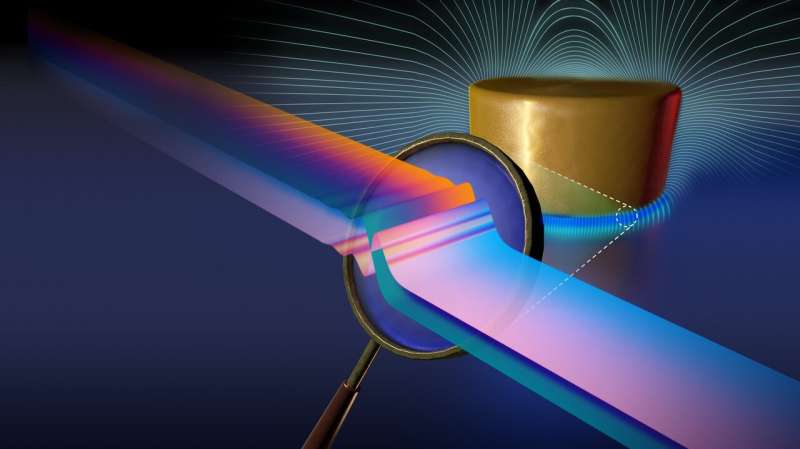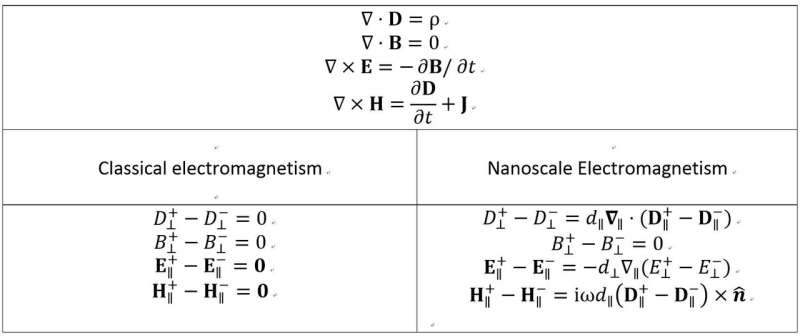Cheers! Maxwell's electromagnetism extended to smaller scales

On Dec. 11, 2019, a general framework for incorporating and correcting for nonclassical electromagnetic phenomena in nanoscale systems will be presented in the journal Nature.
More than 150 years have passed since the publication of James Clerk Maxwell's "A Dynamical Theory of the Electromagnetic Field" (1865). His treatise revolutionized the fundamental understanding of electric fields, magnetic fields and light. The 20 original equations (elegantly reduced to four today), their boundary conditions at interfaces, and the bulk electronic response functions (dielectric permitivity and magnetic permeability) are at the root of the ability to manipulate electromagnetic fields and light.
Life without Maxwell's equations would lack most current science, communications and technology.
On large (macro) scales, bulk response functions and the classical boundary conditions are sufficient for describing the electromagnetic response of materials, but as we consider phenomena on smaller scales, nonclassical effects become important. A conventional treatment of classical electromagnetism fails to account for the mere existence of effects such as nonlocality, spill-out, and surface-enabled Landau damping. Why does this powerful framework break down at nanoscales? The problem is that electronic length scales are at the heart of nonclassical phenomena, and they are not part of the classical model. Electronic length scales can be thought of as the Bohr radius or the lattice spacing in solids: small scales that are relevant for the quantum effects at hand.
Today, the path to understanding and modeling nanoscale electromagnetic phenomena is finally open. In the breakthrough Nature paper "A General Theoretical and Experimental Framework for Nanoscale Electromagnetism," Yang et al. present a model that extends the validity of the macroscopic electromagnetism into the nano regime, bridging the scale gap. On the theoretical side, their framework generalizes the boundary conditions by incorporating the electronic length scales in the form of so-called Feibelman d-parameters.
The d-parameters play a role that is analogous to that of the permittivity , but for interfaces. In terms of numerical modeling, it is necessary to pair each two-material interface with associated Feibelman d-parameters and solve the Maxwell's equations with the new boundary conditions.

On the experimental side, the authors investigate film-coupled nanoresonators, a quintessential multiscale architecture. The experimental setup was chosen because of its nonclassical nature.
Even so, recently graduated postdoc and lead author Yi Yang says, "When we built our experiment, we were lucky enough to run into the right geometry that enabled us to observe the pronounced nonclassical features, which were actually unexpected and excited everyone. These features eventually enabled us to measure the d-parameters, which are hard to compute for some important plasmonic materials like gold (as in our case)."
The new model and experiments are momentous both for fundamental science and for diverse applications. It makes a hitherto unexplored connection between electromagnetism, material science, and condensed matter physics—one that could lead to further theoretical and experimental discoveries in all related fields, including chemistry and biology. Application-wise, this work points to the possibility of engineering the optical response beyond the classical regime—an example would be to explore how to extract more power from emitters using antennas.
MIT Professor Marin Soljacic is enthusiastic: "We expect this work to have substantial impact. The framework we present opens a new chapter for cutting-edge nanoplasmonics—the study of optical phenomena in the nanoscale vicinity of metal surfaces—and nanophotonics—the behavior of light on the nanometer scale—and for controlling the interaction of nanometer-scale objects with light."
More information: A general theoretical and experimental framework for nanoscale electromagnetism, Nature (2019). DOI: 10.1038/s41586-019-1803-1 , nature.com/articles/s41586-019-1803-1
Journal information: Nature
Provided by Massachusetts Institute of Technology
This story is republished courtesy of MIT News (web.mit.edu/newsoffice/), a popular site that covers news about MIT research, innovation and teaching.





















